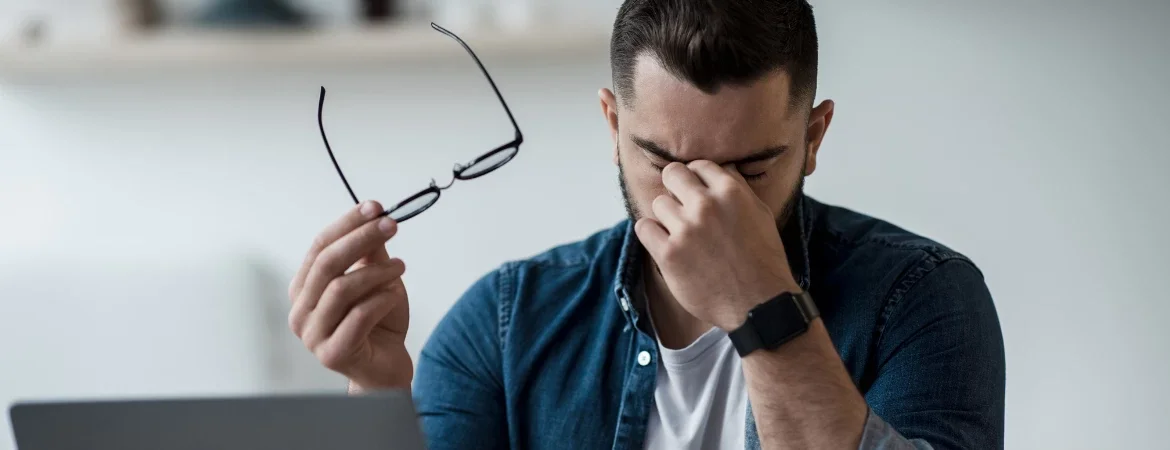
The digital age has brought about a remarkable increase in the use of electronic devices. Whether it’s smartphones, tablets, laptops, or desktop computers, these devices have become an integral part of our daily lives. However, along with the convenience and connectivity they offer, they also come with a downside – eye strain.
Eye strain, also known as computer vision syndrome or digital eye strain, is a common condition that affects individuals of all ages. It occurs due to the excessive use of digital screens and prolonged periods of focusing on these devices. Even though there are several ways to treat the straining of eye at home, it is best to get consultation from an eye hospital where you trust.
Table of Contents
ToggleCauses
Prolonged screen time is a leading cause of eye fatigue in the digital age. With the constant exposure to digital screens and the blue light emitted, our eyes are subjected to prolonged strain. It is important to note that poor lighting conditions can also contribute to eye strain. Excessive glare or dim lighting can put additional stress on the eyes, leading to discomfort and fatigue.
Another common cause of eye fatigue is incorrect vision prescriptions or the absence of regular eye exams. When our vision is not properly corrected, it can put unnecessary strain on the eyes, especially during extended screen time. Regular eye exams are essential for ensuring that our vision prescriptions are up to date and accurate, thus reducing the risk of eye strain.
Environmental factors also play a role in eye fatigue. Dry environments, such as those with low humidity or air conditioning, can cause our eyes to become dry and irritated. Smoke and air pollution can also exacerbate eye discomfort and fatigue, making them additional factors to consider in the causes of eye fatigue.
Symptoms

Recognizing the symptoms is crucial for early detection and prevention. Common symptoms include:
- Eye fatigue: A feeling of tiredness or heaviness in the eyes.
- Dryness or watering of the eyes: Eyes may feel dry, gritty, or excessively watery.
- Blurred or double vision: Difficulty focusing or seeing objects clearly.
- Headaches: Recurrent headaches, especially in the front or temples.
- Increased sensitivity to light: Discomfort or pain when exposed to bright lights.
- Difficulty focusing: Struggling to maintain clear vision or adjust focus.
- Neck or shoulder pain: Physical discomfort in the neck or shoulder region
- General eye discomfort: A sense of overall discomfort or irritation in the eyes.
These symptoms may vary in intensity and can occur individually or simultaneously. It’s important to note that these signs may also arise from other underlying conditions, so it is recommended to consult with a healthcare professional for an accurate diagnosis.
How to Prevent?
Preventing eye strain requires adopting healthy habits and making conscious changes in daily routines. By following these eye care tips, you can reduce eye strain and maintain optimal eye health:
- Take regular breaks: Remember to take frequent breaks from screens to give your eyes a rest. Follow the 20-20-20 rule: every 20 minutes, look away from the screen and focus on an object 20 feet away for 20 seconds.
- Maintain proper posture: Sit at an ergonomically correct position with your screen at eye level. Avoid slouching or leaning too close to your device, as it can strain your eyes and neck.
- Adjust lighting conditions: Ensure that your workspace has adequate lighting. Avoid excessive glare or dim lighting, as it can put unnecessary strain on your eyes.
- Use blue light filters or glasses: Blue light filters can help reduce the amount of blue light emitted by screens. Consider using blue light filtering glasses if you spend extended periods in front of digital devices.
- Practice good eye hygiene: Maintain good eye hygiene by keeping your eyes clean and avoiding rubbing them excessively. Remember to blink frequently to prevent dryness.
- Utilize proper ergonomics: Arrange your workspace to promote good posture and minimize strain on your eyes. Use an adjustable chair, desk, and monitor stand to create an ergonomic setup.
- Schedule regular eye exams: Regular eye exams can help identify any vision problems and ensure you have the correct prescriptions for your glasses or contact lenses.
By implementing these preventive measures, you can significantly reduce eye strain and promote better eye health. Taking care of your eyes is essential, especially in today’s digital age.
Treatment
Relieving eye strain requires a multi-faceted approach tailored to the severity of the condition. For mild cases, simple remedies can provide relief. Resting the eyes periodically throughout the day is essential to reduce strain and prevent fatigue. Additionally, applying warm compresses on closed eyes can help soothe and relax the eye muscles, alleviating discomfort.
Lubricating eye drops are another effective option to relieve dryness and provide moisture to the eyes. These drops can help counteract the drying effects of extended screen time and reduce the sensation of gritty or itchy eyes. It is advisable to consult a pharmacist or healthcare professional to select the appropriate eye drop for your specific needs.
Adjusting the settings of your digital devices can significantly reduce eye strain. Brightness levels that are too high can strain the eyes, so it is recommended to lower the screen brightness to a comfortable level. Additionally, increasing the font size and adjusting the contrast settings can make text more legible, reducing the need for excessive eye focusing.
For persistent or severe cases of eye strain, seeking professional eye care is advisable. An eye care specialist can provide a comprehensive evaluation to determine the underlying causes of the eye strain and offer personalized treatment options. This may include prescription glasses with specialty lenses designed to alleviate digital eye strain, vision therapy exercises to improve eye coordination and focusing abilities, or other targeted interventions based on individual needs.



